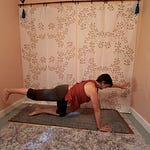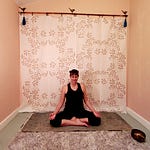I’ve been whirling in my own anxiousness these days. I am trying to show up with whatever it is I know how to do. Today, I’m offering an easy breathing practice you can do anywhere anytime. It’s called the 7-11 breath (insert Slurpee joke here).
The video above is a guided practice. You can do this at your desk (or on the go) whenever you need a moment to collect your calm. Here are some tips:
Inhale to a count of 7. Draw the breath fully in. Try not to cut it short. It might mean you are taking the air in at a little quicker pace.
Exhale to a count of 11. This will definitely feel like a long exhalation. Think of controlling the breath’s slow release.
If this ratio is too difficult, it’s okay. Try 5: 9. Or simply consciously slow down the exhalations so it takes longer than the inhalation. If you feel any discomfort, headache or dizziness, discontinue the practice until we can work together. (spoiler alert… workshop is coming in a couple weeks!)
In the video the first three rounds are counted to help you establish a rhythm. Then for the remainder it allows you to find it on your own without counting for you. The whole practice takes almost 5 minutes. Allow some time at the end as you come back to your innate breath. Relax. Feel your feet on the ground.
Questions about the 7/11 Breath? Ask away! …
Keep reading. Keep breathing.
Full deep breaths are the best medicine for a moment of stress. Emotions, thoughts, and mood can all disrupt our natural rhythm. Distractions create a cycle where altered breathing patterns perpetuate a moody nervous system in fight, flight, or freeze reactions.
Fight or flight: We’ve all experienced moments of anxiety where our breath quickens, heart rate escalates, and the body constricts. In those worried moments, our thoughts fixate on the next moment- then the next- and the next. Without even being conscious of it, our breath follows suit. An uneasy cycle of breath is established, the exhalation is cut short grasping for the next inhale.
Freeze: When we are deeply engrossed in a single spinning thought, we may unknowingly hold our breath. Resisting the next one - it's almost like we hold it all in just so we can keep ourselves together. We don’t want to let go of anything- gripping the breath.
The Breath Blueprint: Stress Relief and Mood Management
Different techniques can inspire various states, either boosting energy or inducing relaxation. Emphasizing the inhale activates the sympathetic branch of the autonomic nervous system, while focusing on the exhale switches on the parasympathetic branch.
During moments of intense emotional reaction, our breath feels drastically different from when we are calmly aware. Lengthening the exhale can slow the heartbeat and lower blood pressure. Breathing deeply also improves heart rate variability, allowing us to transition from an excited state to a state of relaxation more swiftly. A consistent awareness practice enables us to intentionally restore a normal breathing rhythm.
Yoga philosophy has acknowledged the importance of respiratory agility for both physical well-being and calming the mind for over 3,000 years. It’s why there is so much attention to the breath in a vast array of teachings. Breath awareness is key to our asana practice. More importantly it is the foundation to advancing any pranayama practice connecting us to our energetic life force.
It seems so obvious, we’ve been breathing since the second we were born. It is something we don’t even have to think about. We simply inhale and exhale. However, remembering conscious connected breathing in a moment of intensity is where a real shift takes place. It can put us in the driver’s seat of our own nervous system, so we can manage our stress in the moment. Yoga on the mat is training for yoga off the mat.















Share this post